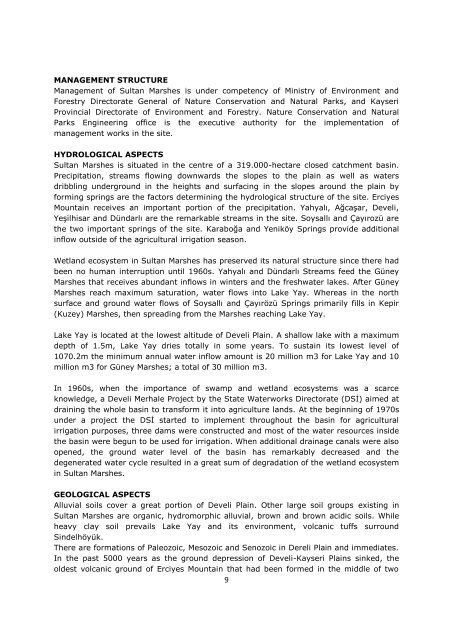Ramsar Sites of Turkey - Ramsar Convention on Wetlands
Ramsar Sites of Turkey - Ramsar Convention on Wetlands
Ramsar Sites of Turkey - Ramsar Convention on Wetlands
Create successful ePaper yourself
Turn your PDF publications into a flip-book with our unique Google optimized e-Paper software.
MANAGEMENT STRUCTURE<br />
Management <str<strong>on</strong>g>of</str<strong>on</strong>g> Sultan Marshes is under competency <str<strong>on</strong>g>of</str<strong>on</strong>g> Ministry <str<strong>on</strong>g>of</str<strong>on</strong>g> Envir<strong>on</strong>ment and<br />
Forestry Directorate General <str<strong>on</strong>g>of</str<strong>on</strong>g> Nature C<strong>on</strong>servati<strong>on</strong> and Natural Parks, and Kayseri<br />
Provincial Directorate <str<strong>on</strong>g>of</str<strong>on</strong>g> Envir<strong>on</strong>ment and Forestry. Nature C<strong>on</strong>servati<strong>on</strong> and Natural<br />
Parks Engineering <str<strong>on</strong>g>of</str<strong>on</strong>g>fice is the executive authority for the implementati<strong>on</strong> <str<strong>on</strong>g>of</str<strong>on</strong>g><br />
management works in the site.<br />
HYDROLOGICAL ASPECTS<br />
Sultan Marshes is situated in the centre <str<strong>on</strong>g>of</str<strong>on</strong>g> a 319.000-hectare closed catchment basin.<br />
Precipitati<strong>on</strong>, streams flowing downwards the slopes to the plain as well as waters<br />
dribbling underground in the heights and surfacing in the slopes around the plain by<br />
forming springs are the factors determining the hydrological structure <str<strong>on</strong>g>of</str<strong>on</strong>g> the site. Erciyes<br />
<br />
<br />
the two important springs <str<strong>on</strong>g>of</str<strong>on</strong>g> the site. ovide additi<strong>on</strong>al<br />
inflow outside <str<strong>on</strong>g>of</str<strong>on</strong>g> the agricultural irrigati<strong>on</strong> seas<strong>on</strong>.<br />
Wetland ecosystem in Sultan Marshes has preserved its natural structure since there had<br />
been no human interrupti<strong>on</strong> until 1960s. <br />
Marshes that receives abundant inflows in winters and the freshwater lakes. <br />
Marshes reach maximum saturati<strong>on</strong>, water flows into Lake Yay. Whereas in the north<br />
<br />
(Kuzey) Marshes, then spreading from the Marshes reaching Lake Yay.<br />
Lake Yay is located at the lowest altitude <str<strong>on</strong>g>of</str<strong>on</strong>g> Develi Plain. A shallow lake with a maximum<br />
depth <str<strong>on</strong>g>of</str<strong>on</strong>g> 1.5m, Lake Yay dries totally in some years. To sustain its lowest level <str<strong>on</strong>g>of</str<strong>on</strong>g><br />
1070.2m the minimum annual water inflow amount is 20 milli<strong>on</strong> m3 for Lake Yay and 10<br />
milli<strong>on</strong> m3 m3.<br />
In 1960s, when the importance <str<strong>on</strong>g>of</str<strong>on</strong>g> swamp and wetland ecosystems was a scarce<br />
knowledge, a Develi Merhale Project by the State Waterworks D<br />
draining the whole basin to transform it into agriculture lands. At the beginning <str<strong>on</strong>g>of</str<strong>on</strong>g> 1970s<br />
<br />
irrigati<strong>on</strong> purposes, three dams were c<strong>on</strong>structed and most <str<strong>on</strong>g>of</str<strong>on</strong>g> the water resources inside<br />
the basin were begun to be used for irrigati<strong>on</strong>. When additi<strong>on</strong>al drainage canals were also<br />
opened, the ground water level <str<strong>on</strong>g>of</str<strong>on</strong>g> the basin has remarkably decreased and the<br />
degenerated water cycle resulted in a great sum <str<strong>on</strong>g>of</str<strong>on</strong>g> degradati<strong>on</strong> <str<strong>on</strong>g>of</str<strong>on</strong>g> the wetland ecosystem<br />
in Sultan Marshes.<br />
GEOLOGICAL ASPECTS<br />
Alluvial soils cover a great porti<strong>on</strong> <str<strong>on</strong>g>of</str<strong>on</strong>g> Develi Plain. Other large soil groups existing in<br />
Sultan Marshes are organic, hydromorphic alluvial, brown and brown acidic soils. While<br />
heavy clay soil prevails Lake Yay and its envir<strong>on</strong>ment, volcanic tuffs surround<br />
<br />
There are formati<strong>on</strong>s <str<strong>on</strong>g>of</str<strong>on</strong>g> Paleozoic, Mesozoic and Senozoic in Dereli Plain and immediates.<br />
In the past 5000 years as the ground depressi<strong>on</strong> <str<strong>on</strong>g>of</str<strong>on</strong>g> Develi-Kayseri Plains sinked, the<br />
oldest volcanic ground <str<strong>on</strong>g>of</str<strong>on</strong>g> Erciyes Mountain that had been formed in the middle <str<strong>on</strong>g>of</str<strong>on</strong>g> two<br />
9
















